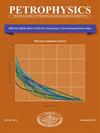基于机器学习的测井预测方法比较研究
IF 0.7
4区 工程技术
Q3 ENGINEERING, PETROLEUM
引用次数: 0
摘要
在测井预处理过程中提高数据质量是一项重要的任务,它会消耗岩石物理学家的大部分时间,对最终的解释有很大的影响。为了提高油田测井数据完整性的自动化和同质性,我们对多个回归模型进行了系统的比较,这些模型成功地预测了井筒测井曲线。当将几口井的测量数据外推到更广泛的井组,预测低质量的数据间隔,并增加完整数据集的可用性时,这些方法可能具有潜在的价值。本研究旨在比较三种有前途的机器学习(ML)方法在预测以下曲线之一时的性能:密度、中子孔隙度和压缩慢度曲线。我们认为有必要评估模型,即使在存在多个缺失的测井曲线或测井曲线发生改变的情况下,也能提供答案,这是岩石物理学中常见的情况。因此,我们基于可以处理这些问题的三种ML方法进行了比较:基于窗口的卷积神经网络自动编码器(WAE),点全连接自动编码器(PAE)和极限梯度增强(XGBoost)。我们开发了PAE和WAE方法来处理感兴趣的具有挑战性的场景,并且我们使用了XGBoost的原始实现,它已经构建用于处理缺失值。我们比较了计算复杂度、预测误差[均方根误差(RMSE)和平均绝对误差(MAE)]、Pearson相关、峰值信噪比(PSNR)以及高尺度和低尺度特征重建的视觉分析,并在两个现场数据集上进行了比较。我们还使用了相同的方法来预测光电因子,并解释了多个油田数据集的地层性质,如总有机含量。本文章由计算机程序翻译,如有差异,请以英文原文为准。
Comparative Study of Machine-Learning-Based Methods for Log Prediction
Improving data quality during log preprocessing is an important task that can consume most of the time of the petrophysicist, with a high impact on the final interpretation. As part of the initiative to increase automation and homogeneity in the data completeness of logs in a field, we organized a systematic comparison of multiple regression models that provided successful predictions of wellbore logs. These approaches can be potentially valuable when extrapolating measurements available on a few wells to a more extensive set of wellbores, predicting low-quality data intervals, and increasing the availability of complete data sets. This study aims to compare the performance of three promising machine-learning (ML) methods when predicting one of the following curves: density, neutron porosity, and compressional slowness curves. We view the need to evaluate models that could provide answers even in the presence of multiple missing logs or logs with alteration, which is a common scenario in petrophysics. Because of that, we built a comparison based on three ML methods that can handle those issues: window-based convolutional neural network autoencoder (WAE), pointwise fully connected autoencoder (PAE), and eXtreme Gradient Boosting (XGBoost). We developed the PAE and WAE methods to handle challenging scenarios of interest, and we used the original implementation of XGBoost, which is already built to handle missing values. We compare the computational complexity, prediction errors [root mean square error (RMSE) and mean absolute error (MAE)], Pearson’s correlation, peak signal-to-noise ratio (PSNR), and the visual analysis of both high- and low-scale feature reconstruction, conducting the comparison in two field data sets. We also used the same methods to predict photoelectric factors and interpreted formation properties such as total organic content in multiple field data sets.
求助全文
通过发布文献求助,成功后即可免费获取论文全文。
去求助
来源期刊

Petrophysics
地学-地球化学与地球物理
CiteScore
1.80
自引率
11.10%
发文量
40
审稿时长
>12 weeks
期刊介绍:
Petrophysics contains original contributions on theoretical and applied aspects of formation evaluation, including both open hole and cased hole well logging, core analysis and formation testing.
 求助内容:
求助内容: 应助结果提醒方式:
应助结果提醒方式:


